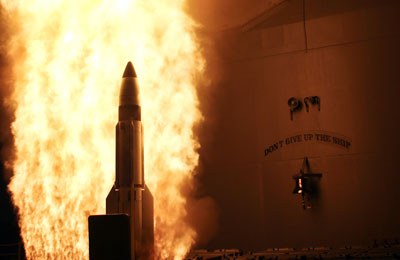Letter: responding to satellite shootdownby Yousaf Butt
|
| Without so much as mentioning even the outlines of a technical risk assessment, let alone a firm number for the risk to individuals from the hydrazine tank, they managed to spend about $50 million of the public’s funds for a thinly disguised ASAT test. |
The well-regarded Aerospace Corporation estimates that “the risk that an individual will be hit and injured is estimated to be less than one in one trillion. To put this into context, the risk that an individual in the U.S. will be struck by lightning is about one in 1.4 million.” Furthermore, if the government is seriously concerned about hydrazine toxicity they ought not be carting the material around the country by rail, sea, and roads.
It is almost certain that the hydrazine tank would have exploded upon re-entry anyway, saving the taxpayers $50 million with next-to-no downside risk. NASA administrator Michael Griffin is quoted as saying that “the tank will have been breached – not probably, but the tank will have been breached – because the fuel lines will have been ripped out of the main spacecraft, and so that hydrazine will vent.”
The temperatures deduced from the ablation signatures on previously re-entered (ruptured and empty) containment vessels indicate temperatures in excess of a thousand degrees Celsius. Even if the hydrazine was frozen, the heat conduction across the thin-shell containment vessel (not to mention the re-entry plasma discharges) would have been sufficient to vaporize and auto-ignite the hydrazine in the contact layer. Hydrazine has a high melting point (approximately 1°C) so the fact it may have been frozen is hardly relevant; since the satellite spent half of its time in daylight the hydrazine would hardly be expected to be at deep-space temperatures.
Quite separately, the vaporized hydrazine in the containment vessel contact layer will also exit from the shorn off fuel lines and there will be ignition at those locations also (due to both heat and plasma discharges), leading to a flash back to the main tank and its subsequent explosion as well. This is very similar to what is known to have taken place with the pyrovalves in Telstar 402 (September 8, 1994) and Landsat 6 (October 5, 1993).
Even if the hydrazine had made it to the ground by some miracle, its toxicity is unclear: a major hydrazine rail spill in July of 1991 between Los Angeles and Santa Barbara led to absolutely no casualties, and even its classification as a carcinogen has been challenged.
If there were real reasons to believe that the tank (and the hydrazine) could have made it to the ground and somehow killed people, the odds of this possibility ought to have been released by the government before they spent $50 million of the public’s money on this exercise. Certainly, if saving lives was a concern, this large sum could have been better used, for example, to improve the health care of wounded Iraq war veterans.
| If there were real reasons to believe that the tank (and the hydrazine) could have made it to the ground and somehow killed people, the odds of this possibility ought to have been released by the government before they spent $50 million of the public’s money on this exercise. |
Releasing the probability number of death or injury from USA 193’s hydrazine tank arrived at by the government’s analysts (one assumes such an analysis was actually done!) would have had no national security repercussions and yet would have allayed fears that the administration is being less than forthright with the American citizens.
On the other hand, if there were other reasons to carry out this interception those ought to be made public immediately: the American government is accountable to the American people even if it means dealing with some “bureaucracy” from time to time.
